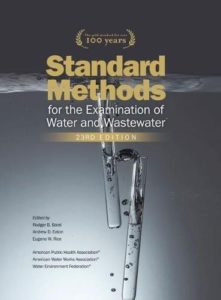Standard Methods for the Examination of Water and Wastewater, 23RD Edition
Standard Methods for the Examination of Water and Wastewater, 23RD Edition
The procedures described in Standard Methods for the Examination of Water and Wastewater intended for use in analyzing a wide range of waters, including surface water, ground water, saline water, domestic and industrial water supplies, cooling or circulating water, boiler water, boiler feed water, and also treated and untreated municipal and industrial waste waters. In recognition of the unity of the water, wastewater, and also watershed management fields, the analytical methods are categorized based on constituent, not type of water.
You can also Read Water and wastewater infrastructure: Energy efficiency and sustainability
The methods of analysis presented in this report as “Standard Methods” believed to represent the best current practice of American water analysts, and to be generally applicable in connection with the ordinary problems of water purification, sewage disposal and sanitary investigations. Analysts working on widely different problems manifestly cannot use methods which are identical, and special problems obviously require the methods best adapted to them; but, while recognizing these facts, it yet remains true that sound progress in analytical work will advance in proportion to the general adoption of methods which are reliable, uniform and adequate.
Standard Methods for the Examination of Water and Wastewater, 23RD Edition Topics![Methods for the Examination of Water and Wastewater]()
- “free” and “albuminoid” ammonia;
- oxygen-consuming capacity;
- total nitrogen as nitrates and nitrites;
- nitrogen as nitrites; and
- statement of results.*
The first edition of Standard Methods for the Examination of Water and Wastewater, 23RD Edition published in 1905. Each subsequent edition has presented significant methodology improvements and enlarged the manual’s scope to include techniques
suitable for examining many types of samples encountered in the assessment and also control of water quality and water pollution. Standard Methods began as the result of an 1880s movement for “securing the adoption of more uniform and efficient methods of water analysis,” which led to the organization of a special committee of the Chemical Section of the American Association for
the Advancement of Science. An 1889 report of this committee, “A Method, in Part, for the Sanitary Examination of Water, and for the Statement of Results, Offered for General Adoption,”


Wow! I’ve been looking all over the internet for a free copy of this book. Thank you very much!